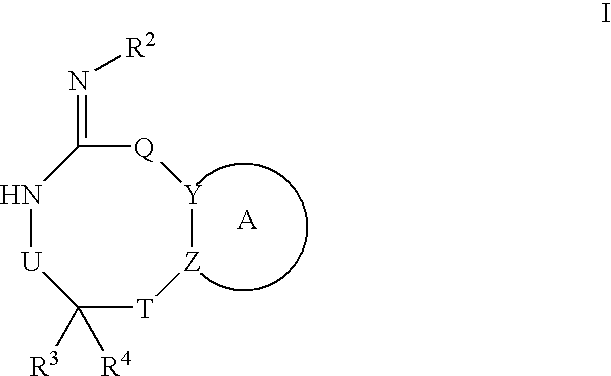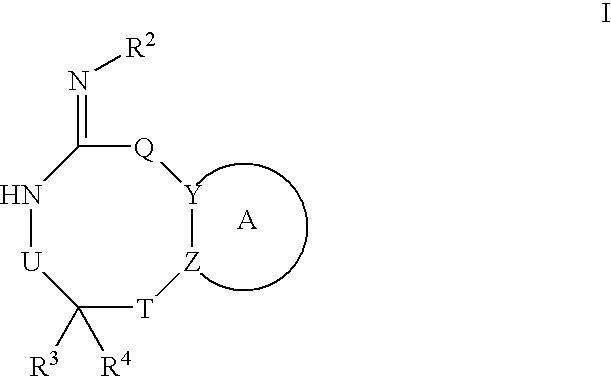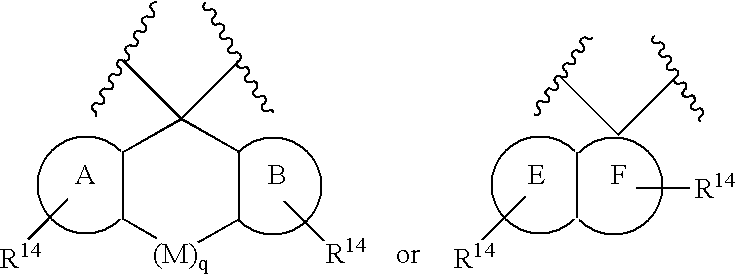Preparation and use of compounds as protease inhibitors
a protease inhibitor and compound technology, applied in the field of heterocyclic compounds, can solve problems such as not preventing disease progression, and achieve the effect of treating or prophylaxis of a related pathologies
- Summary
- Abstract
- Description
- Claims
- Application Information
AI Technical Summary
Problems solved by technology
Method used
Image
Examples
example 1
Compound Example 1
[0307]
[0308]Step 1
[0309]A mixture of 2-benzoylbenzoic acid A1 (11.3 g, 50 mmol) in formic acid (54 g, 1.2 mol) and formamide (29.7 g, 0.66 mol) was heated at refux for 22 h. The solid was collected by filtration, washed with ice-H2O and dried in vacuo to give A2 (10.1 g, 97%). 1H-NMR (CDCl3 / CD3OD): δ=7.77 (m, 1H), 7.39-7.48 (m, 2H), 7.19-7.30 (m, 6H), 5.78 (s, 1H). MS m / e 210 (M+H)+.
[0310]Step 2
[0311]In analogy to the published procedure (M. Eberle and W. J. Houlihan, Tetrahedron Lett., 1970, 36, 3167), a suspension of A2 (2.09 g, 10.0 mmol) in anhydrous CH2Cl2 (60 mL) was treated with 1 M triethyloxonium tetrafluoroborate in CH2Cl2 (12 mL, 12.0 mmol) at RT. The mixture was stirred at RT for 22 h. The reaction was quenched with saturated sodium carbonate (50 mL) and stirred vigorously for 0.5 h. The aqueous layer was extracted with CH2Cl2 (100 mL). The combined organic layers were washed with brine, dried (K2CO3) and concentrated. The residue was purified by column...
example 2
Compound Example 2
[0316]
[0317]To a solution of 2-benzoylbenzoic acid A1 (11.3 g, 50.0 mmol) in TFA (60 mL) was added concentrated H2SO4 (12 mL). Then NBS (13.3 g, 75.0 mmol) was added at RT over 10 min. The mixture was stirred at RT for 3 days. The reaction mixture was poured into ˜100 g of ice-H2O, extracted with EtOAc (200 mL×5). The organic layer was washed with H2O (200 mL×3) and brine, dried (Na2SO4) and concentrated. To the residue was added 100 mL of cold H2O. The product (13.2 g) was obtained by filtration. LCMS showed that ˜62% of desired product B1, 12% of dibromo-products and 23% of starting material were in the mixture. LCMS tR=2.93 min m / e 305 (M+H)+.
[0318]Step 2
[0319]In analogy to the sequence of reactions described in Example 1, BI was converted to B5. 1H-NMR (CD3OD): δ=7.68 (m, 1H), 7.28-7.43 (m, 6H), 7.14 (t, 1H, J=8 Hz), 1.73 (s, 3H). LCMS tR=2.95 min m / e 303 (M+H)+.
[0320]Step 6
[0321]A mixture of B5 (30 mg, 0.10 mmol), 3-cyanophenylboronic acid (22 mg, 0.15 mmol), ...
example 7
Compound Example 7
[0322]
[0323]Step 1
[0324]To a solution of 3-bromopyridine (7.9 g, 50 mmol) in THF (50 ml) was added 2M isopropylmagnesium chloride in THF (22.5 ml, 45 mmol). The mixture was stirred for 2 h and 3-bromoacetophenone (9.95 g, 50.0 mmol) was added. The resulting mixture was stirred for 4 h and quenched with saturated NH4Cl. The mixture was extracted with EtOAc (2×200 ml) and the combined organic layers were washed with saturated NaHCO3 and brine, dried over MgSO4, and concentrated. The residue was purified by column chromatography (gradient 0-70% EtOAc / Hexanes) to give the product Cl (1.68 g, 13%). MS (M+H): 278, 280 Step 2
[0325]A mixture of the product of Step 1 C1 (1.26 g, 4.53 mmol) and thionyl chloride (0.595 g, 5.00 mmol) in anhydrous toluene (12 ml) was stirred at 80° C. for 45 minutes. The mixture was concentrated and the residue was dissolved in DMSO (10 ml). Sodium azide (0.878 g, 13.5 mmol) was added and the mixture was stirred at 50° C. for 1 h. The mixture w...
PUM
| Property | Measurement | Unit |
|---|---|---|
| flow rate | aaaaa | aaaaa |
| temperature | aaaaa | aaaaa |
| temperature | aaaaa | aaaaa |
Abstract
Description
Claims
Application Information
 Login to view more
Login to view more - R&D Engineer
- R&D Manager
- IP Professional
- Industry Leading Data Capabilities
- Powerful AI technology
- Patent DNA Extraction
Browse by: Latest US Patents, China's latest patents, Technical Efficacy Thesaurus, Application Domain, Technology Topic.
© 2024 PatSnap. All rights reserved.Legal|Privacy policy|Modern Slavery Act Transparency Statement|Sitemap



